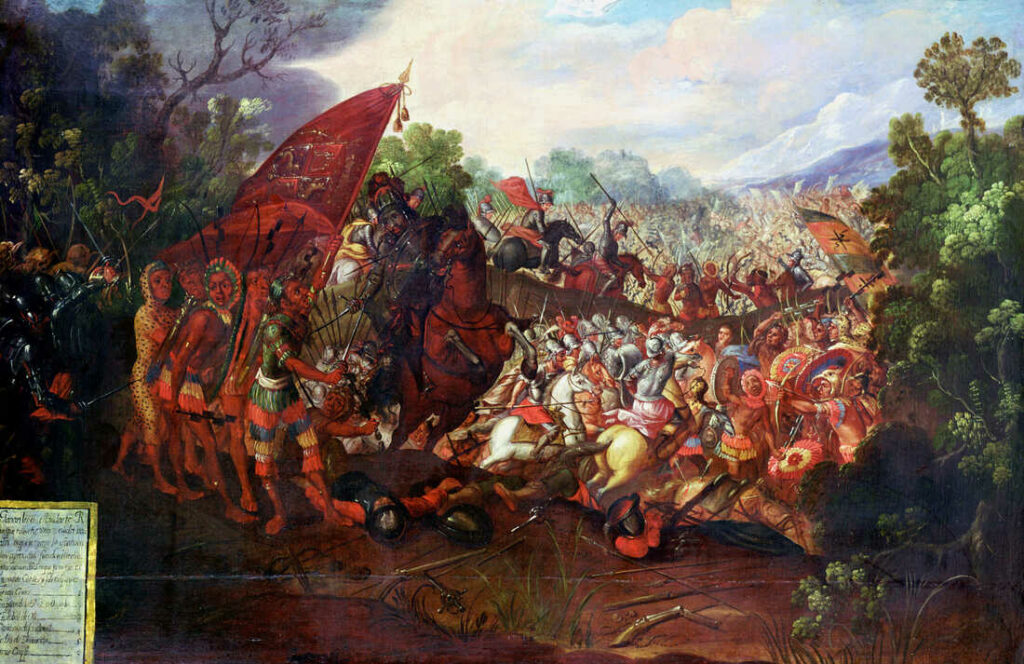The Spanish Conquest of Mexico was a historical event where Spain conquered and colonized Mexico in the 16th century. The conquest had a lasting impact on the indigenous population and culture of Mexico.
It marked the beginning of Spanish colonization in the Americas and led to the decline of the Aztec Empire. Hernán Cortés, the Spanish conquistador, played a crucial role in the conquest by forming alliances with native groups and ultimately capturing the Aztec capital of Tenochtitlan.
The arrival of the Spaniards brought diseases, forced labor, and cultural assimilation, which led to the loss of land, resources, and autonomy for the indigenous people. The Spanish Conquest of Mexico remains a significant event in world history and has shaped the modern-day Mexico we know today.

Credit: brill.com
The Indigenous Civilizations Of Mexico
The Indigenous Civilizations of Mexico were marked by the magnificence of the Aztec and Maya Empires. These complex societies were characterized by their advanced power structures and cultural achievements. The Aztecs, with their capital city of Tenochtitlan, built a vast empire through military conquest and a sophisticated system of tribute and trade. They developed intricate social hierarchies and religious rituals, including human sacrifices, which played a central role in their beliefs and practices. The Mayas, on the other hand, excelled in astronomy, mathematics, and architecture. They built elaborate cities with impressive pyramids and observatories, and their hieroglyphic writing system remains a testament to their intellectual prowess. These indigenous civilizations thrived in Mexico before the arrival of the Spanish conquistadors, leaving behind a rich cultural legacy that continues to fascinate and inspire to this day.
Arrival Of The Spanish Conquistadors
The Spanish conquest of Mexico was a pivotal event in history, forever altering the course of the Americas. The arrival of the Spanish conquistadors marked the beginning of a new era. One of the most prominent figures in this conquest was Hernán Cortés, a skilled and ambitious explorer. Cortés had heard tales of vast riches and powerful empires in the New World and set his sights on claiming them.
The first encounter between the Spanish and the Aztecs was a momentous event. Led by Montezuma, the Aztec Emperor, and Cortés, the two groups clashed in a meeting that would shape the destiny of an entire civilization. Montezuma and Cortés met, each with their own agendas and expectations. Montezuma welcomed the Spaniards, mistaking them for gods, while Cortés saw an opportunity for conquest and riches.
This initial encounter set off a chain of events that would ultimately lead to the downfall of the Aztec Empire and the rise of Spanish dominance in Mexico. The Spanish conquest was a complex and brutal process, but it forever reshaped the cultural, political, and economic landscape of the region.
The Unforeseen Power Struggles
The Spanish Conquest of Mexico – The Unforeseen Power Struggles
The role of disease, specifically smallpox, played a pivotal role in the Spanish conquest of Mexico. The devastation caused by this deadly disease among the indigenous population cannot be underestimated. The lack of immunity and exposure to such a highly contagious disease resulted in widespread death and weakened resistance against the Spanish invaders. As a result, the indigenous alliances became weakened, as they struggled to combat both the Spanish conquest and the outbreak of disease.
Indigenous alliances during this time were complex and multifaceted. While some tribes and individuals chose to collaborate with the Spanish in hopes of gaining advantages, others resisted the conquest fiercely, refusing to surrender their sovereignty and ancestral traditions. The indigenous peoples who chose to ally themselves with the Spanish did so for various reasons, such as protection against rival tribes or benefits promised by the conquerors.
| Allies | Resisters | Collaborators |
|---|---|---|
| Some indigenous tribes aligned with the Spanish in hopes of gaining protection against rival tribes. | Many indigenous individuals and groups fiercely resisted the Spanish conquest, refusing to surrender their sovereignty and culture. | Some indigenous people collaborated with the Spanish, seeking benefits promised by the conquerors. |
The Battle For Power
The Spanish Conquest of Mexico was a pivotal event in the history of the Americas. As the battle for power unfolded, the Siege of Tenochtitlán emerged as the final showdown between the Aztecs and the Spaniards. The Aztecs, led by their emperor Moctezuma, faced the relentless persistence of the Spaniards, led by Hernán Cortés.
The Siege of Tenochtitlán: This epic conflict lasted from May to August 1521. The Spaniards, with their superior weaponry and alliances with local tribes, laid siege to the Aztec capital, Tenochtitlán. The city was situated on an island in Lake Texcoco, making it difficult to conquer. However, the Spaniards used various tactics, such as blockading the city and cutting off food and water supplies. The battle was fierce, with both sides displaying immense bravery and determination.
Aztec Resistance: The Aztecs defended their city valiantly, but they were outnumbered and outgunned. They fought with weapons such as macuahuitls and obsidian blades, while the Spaniards wielded steel swords and firearms. Despite their efforts, the Aztecs succumbed to the superior firepower and strategies of the Spaniards.
Spaniard Persistence: Hernán Cortés and his men were determined to conquer and annex the Aztec empire. They were driven by a thirst for wealth, power, and religious conversion. Through a combination of military prowess, political maneuvering, and alliances with rival tribes, the Spaniards eventually emerged victorious.
The Aftermath Of Conquest
The Spanish conquest of Mexico had a profound impact on the region, resulting in significant changes and transformations. The arrival of the Spanish brought about a process of colonization that had far-reaching consequences for the indigenous population. The Spanish implemented their own political, economic, and social systems, which resulted in a dramatic shift in power dynamics.
The indigenous people faced numerous challenges in the wake of the conquest. Many of their traditional ways of life were disrupted, and they were subjected to systems of forced labor and exploitation. However, despite these difficulties, indigenous communities also demonstrated resilience and resistance. They fought to preserve their cultural practices and identity, and some even managed to maintain pockets of autonomy within Spanish-controlled territories.
The Spanish conquest brought about lasting changes to Mexico, both positive and negative. The introduction of new crops, animals, and technologies had a profound impact on the region’s economy and society. Additionally, the blending of Spanish and indigenous cultures resulted in the emergence of a unique mestizo identity that continues to shape Mexico’s cultural landscape to this day.
Unveiling The True Power Dynamics
The Spanish conquest of Mexico revealed an intricate power dynamic that is often overlooked in historical narratives. By reevaluating the traditional account, we can shed light on the significant contributions and agency of Indigenous peoples during this pivotal period.
Understanding the complexity of power in conquest is essential to gaining a comprehensive perspective. The conquest was not simply a one-sided subjugation but rather a multifaceted interaction. Indigenous groups, such as the Aztecs and Mayans, possessed their own systems of governance, culture, and military prowess. These factors played a vital role in shaping the outcome of the conquest.
The narratives around the Spanish conquest tend to prioritize the European perspective, overshadowing the Indigenous achievements. However, it is crucial to recognize the Indigenous contributions in areas such as agriculture, medicine, and technology. Additionally, the alliances and resistance efforts of Indigenous groups challenged the notion of complete Spanish domination.
By reevaluating the narrative and embracing a more inclusive perspective, we can unravel the true power dynamics that were at play during the Spanish conquest of Mexico. This allows us to recognize the agency and resilience of Indigenous peoples, contributing to a more nuanced understanding of this significant historical event.
Frequently Asked Questions On The Spanish Conquest Of Mexico
How Did The Spanish Conquer Mexico?
The Spanish conquered Mexico through a combination of military might, alliances with native tribes, and the spread of diseases like smallpox that weakened the indigenous population.
Who Was The Leader Of The Spanish Conquistadors In Mexico?
Hernan Cortes was the leader of the Spanish conquistadors during the conquest of Mexico. He led the expedition that ultimately led to the fall of the Aztec Empire.
How Long Did The Spanish Conquest Of Mexico Take?
The Spanish conquest of Mexico took approximately two years, from 1519 to 1521. During this time, Hernan Cortes and his conquistadors fought numerous battles and established Spanish control over the region.
Conclusion
The Spanish conquest of Mexico had a profound impact on the history of the region. It not only marked the beginning of colonization and the introduction of European culture, but also led to the downfall of the Aztec empire. The conquest resulted in significant changes in politics, society, and religion, shaping Mexico into the country we know today.
It is imperative to understand and reflect upon this historical event to gain a comprehensive understanding of Mexico’s rich cultural heritage.

